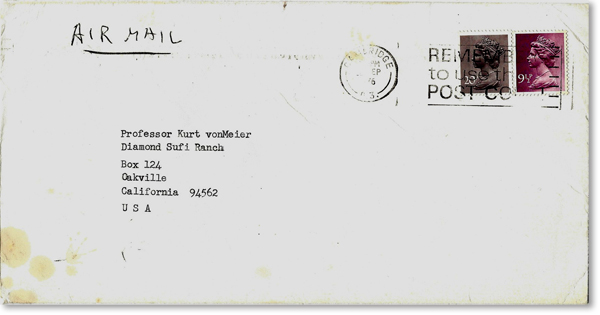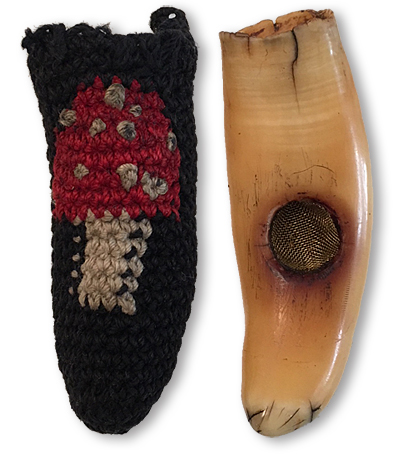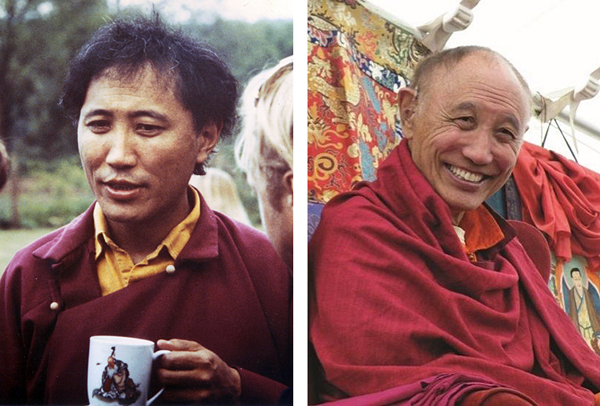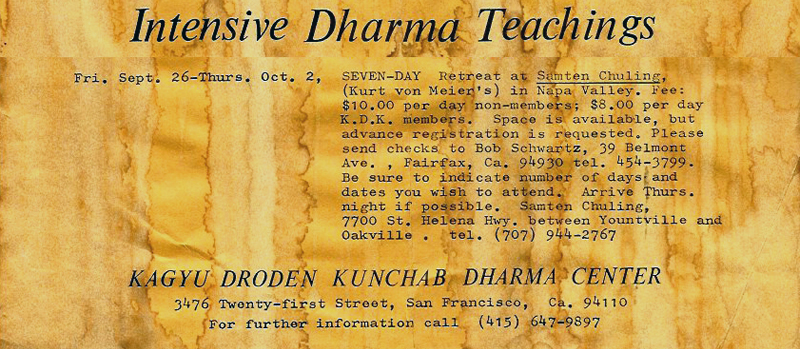A booklet written by cyberneticist Heinz von Foerster was tucked amid Kurt’s archives, a document Kurt concluded was worth retaining. Entitled “On Constructing a Reality,” the twelve-page excerpt from a von Foerster address of 1973 puts forth the following postulate: “The Environment As We Perceive It Is Our Invention.” Von Foerster then goes on to make his case in support of this postulate. Heinz’ inscription to ”Walter and friends” refers to Walter (Clifford) Barney and Kurt von Meier. The booklet, in its entirety, is reproduced here.
Ed "Big Daddy" Roth
Kurt considered Ed “Big Daddy” Roth (March 4, 1932 – April 4, 2001) to be a significant artist. Roth created visions of the “hot rod” through cartoons, models and customized car creations, and burnished the image of the hot rod bad-boy through exaggerated, even demonic-looking characters. Kurt loved cars, especially “hot” cars like Ferraris and Maseratis, both of which he owned later in life. The “Firebird” illustration above was sent to Kurt by Ed Roth in 1968. Naturally, Kurt kept it, along with the note on its reverse side and the envelope in which it was delivered.
The Realist 1973: Defying the Laws of Form at the AUM Conference
There are few first-hand accounts of the AUM Conference at Esalen in 1973. Clifford Barney’s account in the Pacific Sun Newspaper is one, and this article by Carole Levine in Paul Krassner’s iconic publication The Realist, is another. Von Meier tape recorded all the discussions and Barney produced transcripts of the tapes (all available here), but Levine’s account provides yet another, and less technical, slant on the conference and its participants. Here’s link to all AUM Conference articles on this website.
Gregory Bateson, Douglas Kelly and Heinz von Foerster at the AUM Conference
This recording made by Kurt von Meier during the AUM conference at Esalen includes a short Tuesday evening discussion led by mathematician Douglas Kelly and a longer Wednesday morning session dominated by a presentation by Gregory Bateson, an English anthropologist, social scientist, linguist, visual anthropologist, semiotician, and cyberneticist (pictured above circa 1974), followed by group discussion. Heinz von Foerster provides his insights about paradox, tautology and contradiction while others -- Kurt von Meier, Alan Watts, and Douglas Kelly chime in with their perspectives. While focused on the mathematics of Laws of Form, the recording contains welcome moments of humor and laughter as the group struggles to make sense of G. Spencer Brown's ideas. The recording lasts about one hour and a half; the volume varies as speakers were in differing positions relative to the single microphone.
Karekare
Unexpected treats come this way now that Kurt’s archives are online; one such treat is this painting by Kurt, “Karekare” (Karekare is a black sand beach on the violent Tasman coast west of Auckland). The inquiry came through the contact form on this website and included this information: “The Chartwell Collection has acquired a work of Kurt's, Karekare, pva on Board, dated 1962, signed, 565 x 1200mm, from an Auckland auction of works from the John Perry Collection. John was a student of Kurt's at Elam.”
Golden Gate International Exposition - 1939
In 1939, when Kurt was five years old, he and his family visited the Golden Gate International Exhibition on San Francisco Bay, what we today call a “World’s Fair.” By all accounts, Kurt’s mother Dorothy loved the exhibition, and that prompted several return visits. The von Meier family was living in Berkeley at that time. (Left: Julian and Dorothy von Meier in 1940). This guidebook was passed down from Kurt’s mother to Kurt’s sister Kathie, who made it available for posting on this website.
The Gestalt Agent's Handbook
In 1972, Kurt’s later-to-be friend and Diamond Sufi Ranch resident, Walter (Clifford) Barney wrote a thesis about Gestalt Therapy while pursuing a Master’s Degree in Counseling. His collaboration with two friends became as much of the subject of his thesis as Gestalt Therapy itself—his documentation of their interaction a practical demonstration of the Gestalt process. Combining concepts with process documentation, this paper anticipated elements of what is conventionally referred to today as “mindfulness” training, bring attention to body-mind awareness.
Barney writes, “Most people read books in order to learn something from them. By writing a book, we collude with this expectation of the reader. We deal with this trap in two ways: by letting the reader watch our process as we write the book, and so become aware of our dilemma; and by playing verbal tricks on him, so that when he begins to think that he learns from us, rather than from himself, he suddenly finds himself in a blind alley, logically.”
Heinz von Foerster on Computing a Reality
Heinz von Foerster (pictured at left during the AUM Conference), scientist and expert in cybernetics, delivered an engaging talk during the AUM Conference at Esalen in 1973 about the way in which we as individuals form hypotheses about reality, confirm them and then construct descriptions of that reality. He also reviews the function and limitations of our sensory apparatus, and how we know what we know.
Kurt von Meier recorded von Foerster’s talk; his presentation lasts about 30 minutes.
Letters from James Keys (G. Spencer Brown)
For a while, Kurt von Meier and Walter (Clifford) Barney established an on-going relationship with James Keys, aka G. Spencer Brown, poet, mathematician and author of Laws of Form. They exchanged letters and corresponded after Brown’s attendance at the AUM Conference at Esalen in 1973. In these two letters from Brown in September of 1976, he makes special note of Kurt and Walter’s appreciation and understanding of his work. “Before enlightenment people deal only in opinions, afterwards there can be only an exchange of gifts, as in heaven. It is important how pretty the ribbons are. You and Kurt are the only members of the team with any clout who have realized this.”
"The Tooth"
One of Kurt’s most prized—and well-used—possessions was his whale’s tooth pipe (actual size, 2 3/4” in length). Discolored by years of resinous smoke and oils from being handled, when “The Tooth” (as it was affectionately called) came out, it was an invocation of the sacred, and an indication of moving into the wild and intoxicated realm Kurt’s Dionysian self so enjoyed. Kurt’s friend Paula Reinking knitted a special “sock” to protect The Tooth, emblazoned with a depiction of an Amanita Muscaria mushroom, of course!
The Square Root of Minus One
Kurt was so intrigued with the imaginary number “i” symbolized by this expression he had a T-shirt made. Kurt had all sorts of T-shirts in his wardrobe—ranging from declarative to contemplative—yet another dimension of his expressive personality. The same was true of hats, and for that matter, socks, shirts, pants, belts and so forth. Not the type to just throw on anything, Kurt thought about how he dressed, and had the closet of a clothes horse.
Lama Chime at the Diamond Sufi Ranch in 1975
In September of 1975, Benchen Radha Tulku, also known as Lama Chime Tulku Rinpoche, visited Kurt's Diamond Sufi Ranch for a week-long retreat. (Above left: Chime Rinpoche in the late 1970s; above right: Chime Rinpoche in 2010) The Ranch was often host to teachers and healers of various traditions. Born in 1941 in Kham, Tibet, Chime Rinpoche was one of the first of the Tibetan Lama's to begin teaching in the West, and as Lama in the Kagyu-pa school of Buddhism was associated with HH the 16th Karmapa. Here is a segment from one of his first talks--on the Four Noble Truths--and his conversation with retreat participants.
This is a portion of the flyer announcing Lama Chime’s teaching retreat in 1975 at the Diamond Sufi Ranch, which the Lama re-named Samten Chuling.
"FUCK HATE" - Kurt's Testimony at the "Earth Rose" Obscenity Trial, 1968
From today's perspective, this court transcript from 1968 seems rather quaint, but it represents a transitional moment in American culture. The publication Earth Rose, created by poet Steve Richmond, was declared obscene in Los Angeles County, California; he was charged and a trial on a misdemeanor charge was held. Here's background on the case. In addition to a written statement, Kurt testified in person on behalf of the defendant. In doing so, he had the opportunity educate the judge about literary criticism and the history of poetic styles. Ironically, the word "Fuck"--its use still illegal in some settings--is liberally spoken and its meaning explored during the trial. From the transcript:
THE COURT: Well, what works, if any, would you consider to be obscene?
THE WITNESS: Okay. Let me talk about this publication for example. I would say if you had your choice between two words and one of them were obscene, it would be "Hate" that is obscene.
THE COURT: "Hate" is obscene?
THE WITNESS: And not "Fuck." I think there is a lot of hate and I am speaking very personally here. I am not for a minute suggesting that this was the intent of the poet, but if something morally offends me, it is to see human suffering that is permitted to continue knowingly, and I think that is working definition of hate.
I think that does happen in the world today. It is no new revelation. All of us know it. I think that some scenes of people dying in our living rooms on television in the war in Vietnam rightly or wrongly, I am not suggesting that, I am speaking as a veteran. I have served my time. I have no problem about that.
THE COURT: No.
THE WITNESS: I am saying that here our problem is when women and children are shown dying and somebody opens another can of beer, that gets much closer to the sense of what is obscene in the world.
Illustrations and hyperlinks have been added to this transcript that further illuminate the references made in the hearing.
THE SHEN YANTRA
In this essay, Kurt's longtime friend and Vajrayana Buddhist practitioner Joe Duane generously provides some background about the Shen Yantra (above) which occupied Kurt's devoted attention and appeared on the poster promoting the exhibition of his teaching collection. Joe explains the origination of the Yantra in Bon (pre-Buddhist) Tibetan ritual, and its underlying role in the construction of ritual sand mandalas.
Los Angeles Times Coverage of von Meier's "Dismissal" from UCLA in 1967
This article from March 4, 1967 covers Kurt von Meier’s “dismissal” from UCLA, an event that would change the course of Kurt’s teaching career. Reporter Art Seidenbaum notes, “To the study of painting and sculpture von Meier brought added attractions; underground movies, avant-garde poetry, visiting Pop painters and—most lively of all in a curriculum already emblazoned with living color—throbbing rock 'n' roll musicians.”
On Audio: G. Spencer Brown at the AUM Conference - Final Remarks
As Clifford Barney has written, Brown departed the AUM Conference in 1973 after only two days of attendance, concluding his visit with these final remarks about Laws of Form and its underlying mathematics. From his tone, one senses Brown felt he'd said everything he had to say; he encouraged his "audience" to ask a couple of questions. What ensued was wonderful; lucid, intriguing and entertaining remarks about The Five Levels of Eternity, consciousness and contradiction, Eastern vs. Western concepts, the use of injunctive language in mathematics, mystic utterances, and that "there's no feedback in heaven." The talk runs about 35 minutes.
Jene LaRue's "The Meanings of Mythology"
Jene LaRue (pictured above), one of Kurt's partners in the Diamond Sutra Restaurant, was a fellow-Princetonian, and went on to become a professor of classics. This paper, The Meanings of Mythology, encapsulates Jene's view of mythology, its origins and its continuing influence on modern life. Filled with interesting and valuable insights, the paper's ideas can also be seen in Kurt's writings. Kurt authored some commentary on Jene's essay. Both Jene and Kurt looked through--not just at--society and human activity to the divine in action. The link below will open Jene's paper in a new window, and can be printed as a PDF.
Kurt's Navajo Blankets
Kurt was an avid collector, particularly fond of textiles and blankets. Having traveled to the southwest to visit the Hopi, he acquired a large number of antique Navajo blankets of extraordinary beauty and significance. He discussed their use and meaning in his lectures, and on chilly nights at the Diamond Sufi Ranch he'd sleep warmly beneath them. Read more to see some examples from his collection (images courtesy of Ishi von Meier, Kurt's grandson).
Tarjeta de Turista Para Multiples Viajes
The Idea Institute
The Idea Institute was a presentation of the University of California Extension, and reflected how deeply new ideas about art and communication were overtaking modern society in the late 1960s. In addition to Kurt von Meier, the speakers included Mel Blanc (the voice of Bugs Bunny), Fordham University Communication Arts Professor Edmund Carpenter, Sociology Professor Lewis Yablonsky and others. As usual, Kurt made notes prior to his remarks; to see them, read more.
































